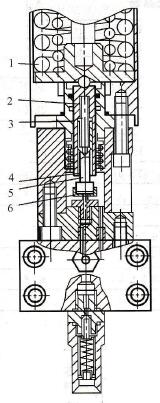High-voltage circuit breaker operating mechanism safety valve
(1) The structure of the liquid pressure safety valve. Take the structure of a liquid pressure safety valve as an example, and its structure is shown in Figure 1. It is mainly composed of combined springs, springs, pistons, circlips, guide rods, gaskets and other components.
(2) The working principle of the liquid pressure safety valve. The safety valve in the hydraulic operating mechanism and the compressed air operating mechanism is also a special form of pressure relay. The difference is that the safety valve does not have electrical contacts and operates in different ways. It is a safety protection device when the pressure is too high when the electric motor oil pump or air compressor system fails. When the oil pressure or air pressure exceeds the specified maximum pressure value, its internal mechanism will act. When the pressure is released to the specified pressure value, the safety valve will automatically close.
(3) The working process of the liquid pressure safety valve. When the oil pressure in the hydraulic operating mechanism rises, the piston 3 is pushed to move upwards. When the pressure reaches a certain value, the circlip 4 drives the guide rod 5 to move upwards, so that the gasket 6 leaves the valve port to release the oil and pressure. At this time, the piston 3 moves down again under the action of the combined spring 1, and the guide rod 5 returns under the action of the spring 2. When the pressure drops to a certain value, the sealing gasket re-seals the valve port to relieve the pressure stop. The actions of pressure relays and safety valves are only related to pressure, not temperature.
Figure 1 The structure of the liquid pressure safety valve

1-combined spring; 2-spring; 3-piston; 4-circlip; 5-guide rod; 6-seal




